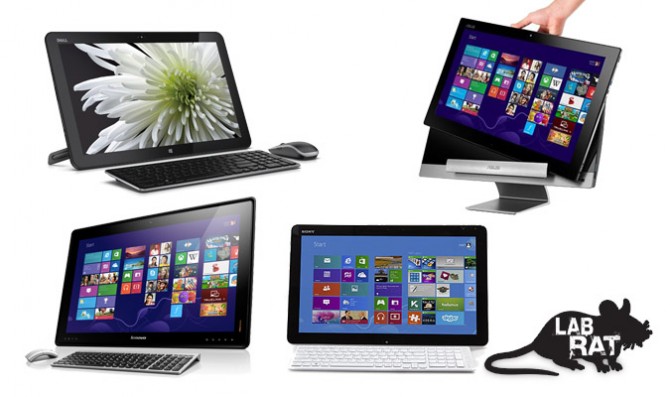5 Reasons Large-Screen Tablets Are the Next Big Thing
Last year, Toshiba introduced the Excite 13, an Android tablet with a ridiculously mammoth 13-inch display. At the time I thought this super-size slate was more of a curiosity than anything else. As it turns out, it was just too small.
With the recent announcement of the Dell XPS 18, there are now four plus-size portable all-in-ones either on the market or coming soon. All of these devices come with built-in batteries that let you, in theory, carry them around like a tablet. It may seem crazy, but these devices have a real chance at succeeding. Here’s why.
1. They're portable.
With a battery life of less than 4 hours and a weight of 11.2 pounds, Sony didn't seriously expect people to carry the Tap 20 around all that often. But with the XPS 18—which weighs just less than 5 pounds—a portable all-in-one starts to make sense. The idea isn't so much that you’re going to take it on the subway, but that you can use it as a desktop, and, when you want to surf the Web while lounging on the couch and watching TV, well, you can do that too.
2. They can bring the whole family together.
The companies making portable all-in-ones are adding apps that encourage multi-user participation, such as games. Lenovo has made this benefit a focus with the Horizon PC table-top "tablet," so the whole family can play games together. Imagine "Monopoly" for the 21st century—of course, you’ll still argue over who gets to be the car.
More: Top 25 Windows 8 Apps
Sign up to receive The Snapshot, a free special dispatch from Laptop Mag, in your inbox.
3. They actually replace two devices with one.
I’m somewhat in agreement that trying to put a notebook's functionality in a tablet is like combining a refrigerator and a toaster. However, that's because a 10-inch tablet is too small to get real work done. The bigger screen size and higher resolution of these portable all-in-ones will, at the least, make multitasking easier. These are tablets for the home that double as the primary family PC.
4. They're adaptable to different user types.
When you have a device intended for whole-family use, it's helpful if it can support different case usage scanarios. That's what especially intrigues me about the ASUS Transformer All-in-One. Not only can it switch between Windows 8 and Android, but, when docked, you get the power of a discrete Nvidia GeForce GT730M GPU. So, you can go from simply checking your email or browsing the Web on your couch to some serious gaming at your desk.
More: Top Windows 8 Tablet-Laptop Hybrids
5. They're not too expensive.
Currently, an HP Envy 20 TouchSmart All-in-One desktop PC costs $879 and includes a 3rd-generation Intel Core i3 processor, a 20-inch, 1600 x 900-pixel display, 6GB of RAM and a 1TB hard drive. The Dell XPS 18 starts at $899, which will get you an 18.4-inch, 1080p display, an Intel Pentium dual-core 2117U processor, 4GB of RAM and a 320GB, 5,400-rpm hard drive. So while you'll be giving up some power for portability, the trade-off will make sense to a lot of consumers.
More: Top Laptops Under $500
Bottom line
Of course, there's still room for improvement. What these larger-than-life tablets really need is a built-in IR blaster, like the Sony Xperia Tablet Z or the Samsung Galaxy Note 10.1, so you can control your TV, stereo or even the lights and thermostat. Wireless charging would go a long way, too. Given their comparatively short battery life, it would be a no-brainer if you could recharge an all-in-one just by dropping it on a pad placed on your coffee table or desk.
Overall, though, super-size tablets have the potential to take over the living room—or any other room of the house—in a way that traditional all-in-ones and smaller tablets haven't.
Michael was the Reviews Editor at Laptop Mag. During his tenure at Laptop Mag, Michael reviewed some of the best laptops at the time, including notebooks from brands like Acer, Apple, Dell, Lenovo, and Asus. He wrote in-depth, hands-on guides about laptops that defined the world of tech, but he also stepped outside of the laptop world to talk about phones and wearables. He is now the U.S. Editor-in-Chief at our sister site Tom's Guide, where he oversees all evergreen content and the Homes, Smart Home, and Fitness/Wearables categories for the site..

